Took a trip to the River Wye at the end of May with our Australian visitor “OZMan” to show him what it’s like in a country that has rather more water and lush growth than they get down under. A fantastic trip again in gorgeous late spring weather, OzMan even took a dip in the river and climbed tup to the top of Yat Rock, he was really struck by the beauty of our English countryside. I lent him one of our genuine Australian swags so he’d feel right at home! Somewhere along that lazy river as the evening drew in towards dusk I spotted a rare “Hobby” falcon flashing over the surface of the water catching bugs, something I’ve never seen before – a really beautiful bird, with a very distinctive agile flight full of twists and turns as it races after dragon-flies and moths, eating them on the wing. As the canoe drifted silently on the water we came very close, right under a branch where it had stopped to rest for a while, so I could see that striking red underside and dark moustache features. But it’s in flight you want to see this bird – a really magical experience, and one you’d be unlikely to see except from down at the water level in a canoe, approaching silently on the water.
Tag Archives: River Wye
Stoatally Different Canoe Trip…
On Saturday 24th, we took ‘Old Red’ (our newest canoe, an Old Town Discovery 158) on its 3rd trip, on another ‘over-nighter’ on the River Wye. The river was quite low with the recent fine weather and Spring has now properly arrived at last. We didn’t see the Peregrines this time but were treated to a lengthy sighting of a Stoat, hunting alongside the riverbank.
It moved quickly in the cover but we could see the distinctive white chest and black tip of the tail clearly – How to tell a Stoat from a Weasel? Just remember this old rhyme: A Stoat is Weasily recognised, as it Stoatally different from a Weasel!
I rigged up an improvised shelter with my tarp as we expected some rain at night and sure enough, at around 3am, the showers started.
The birdsong took over from the rain at 6am and it was incredible to hear this chorus again. The protective Canada Goose we’d seen on the last trip left us alone as we passed this time – he seemed a bit more relaxed about canoeists. Mrs Goose was still up on the nest as he eye-balled us from the other side of the river. Only a few Buzzards this time and the Owls were fairly quiet – and no visits from the Mink at camp – all in all, a Stoatally different trip!
Baker Tent Hunt – the half-dome shelter
In addition to the full size campfire tent and lightweight versions we’ve looked at, one of the simplest ways to achieve a ‘campfire tent’ setup would be the ‘half dome shelter’.
Source: Period Shelters -http://poisonriverparty.homestead.com/Shelters.html
In fact this construct was used widely in woodland camping by the North Eastern native American populations. One such construction was shown in Ray Mears series on “Rogers Rangers” an exploration of how WIlliam Rogers led expeditions and raiding parties in the early british military campaigns in the Frontier country with Canada, fighting both the French and the opposing native tribes. The demonstration by a descendent of the local tribes showed how a half dome shelter would be built. Interestingly the structure of the frame would be made at the camp site, from materials found thereabouts, whilst the covering was made from wide sheets of birchbark, which being the most valuable material as well as extremely lightweight, would be carried from camp to camp – a new frame simply being built as required at the next location.
Ray shows how with a fire built out front the shelter is extremely insulating, and practical allowing easy access in and out, and the ability to cook under cover using the fire in front of the shelter. These are all characteristics of the “Campfire Tent” or “Baker Tent” we were looking for.
That episode showed a beautiful end result of this technique – I am keen to try this technique, but using a tarp instead of birchbark.
So in searching for a modern version of this ‘half-dome campfire tent’ i began looking into surprisingly fishing “bivvies” which typically do have this half dome shape, as well as a rigid or semi-rigid frame built in. There are many types of these bivvies on the market, with the key differentiating from our point of view being weight and b8ulk, as we will want to carry this in a canoe, as well as portaging where necessary.
So clearly some of the larger more heavy duty fishing shelters, or “carp bivvies” or “brollys” as they are also known in the world of course fishing are not suitable in this case. The most interesting I found were these two:
The Fox Evolution XS Shelter/Bivvi.
This has a rigid, interlocking hooped frame which interestingly stays in place when the shelter is collapsed, making setting up and taking down very quick and simple, as well as great resistance against the wind. Also importantly this one can be set lower in bad weather, another feature of Bill Mason’s campfire tents – that of being highly adjustable to the weather conditions. Here’s a pic:
(a good review here) The downside of course here is that its still quite heavy at 4.2kg (if you compare to a tarp/pole/line setup), but even more importantly its bulky at 1.9m long (!) and 11cm’s diameter size when packed.
All the fishing bivvi info you’ll ever need is here at http://www.bivvies.co.uk/
The Wychwood Rogue Shelter.
This is the most lightweight of the bivvi shelters, with simple shock-corded poles in place of more rigid frames, but again the ability to change the shape significantly from wide open and high at the front very low and enclosed in bad weather. The shelter is extremely lightweight, has good fixings and guy ropes and is very easy to put up (once you’ve tried a few times – at first its quite confusing!). So this one really began to get our attention and we purchase one on Ebay for an incredibly cheap price of just £25, compared to the normal price of about £48. It was a brand new and unpacked one…and in fact the chap who sent it out actually sent out 5 in one box not realising it was a group – I let him know and he arrnged for the others to be picked up – we’re an honest lot here.
So the Wychwood shelter in backyard and canoe trip test turned out be absolutely excellent – the only downside that the poles although light, because they aren’t designed for canoe camping as such are quite long at about 5 foot, rather than being made up of shorter sections- and that does make it a bit big or rather long in the boat, although its no real problem.
The Shelter when set up really does make exactly the half-dome ‘campfire tent’ shelter we were after, and even looks very much like the native american shelters that inspired the idea. It’s a fantastic shape and has only one downside I can see – which is faced into strong winds it can take quite a bashing and become unstable – but if you’re on good ground for pegging this hasn’t been a problem for me even in extreme conditions, lowering the front egde means you can position it carefully in the wind, to get some downforce in play as well.
On less good ground for pegs it can be more of an issue. And in fact on a winter camp last year what were the most violent gusts of winds I’ve ever experienced anywhere on 3 continents hit our camp for a short while, probably half an hour only. Fortunately the direction was favourable, as the shelter got buffeted in the back edge forcing the structure down rather than taking it skyward! With some stones to weigh down the back, some extra pegging to a big log and some crossed fingers, the shelter actually withstood this onslaught, however lying in the shelter with all hell breaking loose around me and snow starting to fall (sideways) I was forced to consider ‘what to do IF it was going to fail’. In fact with this shelter there’s a good option here, and one which is actually useful part of the set-up in good weather too: by simply removing the poles you are left with an excellent simple tarp, again with good fixing point and a slight dome shape that helps enormously when constructing a tarp shelter. So the solution would have been to collapse the poles and just cover the swag with a very lower tarp cover, down and out of the wind behind the canoe.
Since then things have changed and although I haven’t yet tried constructing a shelter using sticks with this tarp, I have used it with canoe paddles attached to the canoe for stablity and that really works well – then you simply take the small rolled up tarp part of the shelter and its extremely minimalist as well as being very effective in both wind and rain, with enough room for two people and gear to sit out of the rain.
“Backyard Test” of the Wychwood shelter canoe-tarp rig:
And in use for real on a canoe trip:
So there you have it – the Wychwood shelter is our recommendation for the half-dome campfire tent shelter and as a canoe-tarp rig; so it’s a great buy for the price.
read more in our “Baker Tent Hunt” series.
Autumn on the River Wye
At the first sign of it getting colder and the leaves turning we loaded up and headed for an overnight trip down the Wye to catch the early autumn mood – leaving enough time for a late Autumn trip to follow before winter hopefully…
…
River Wye – Get Out and Stay Out!
A Late Summer trip on the River Wye – just a 24 hour ‘get Out & Stay Out” trip, but a great one – highlights included a 2 foot Pike jumping out of the water within about a foot of the canoe – teeth bared!
…
River Wye – Summer Trip Report
Finally documented our Summer Season Wye trip. We decided to start at The River Lugg – I arrived in daylight (just) and went down the Lugg until it met with the Wye and made camp on the far bank and then waited for a text saying TheRangerD had arrived at Mordiford. That meant I had to cross back over the wye just as it got dark at midnight, and teh bad news the mist suddenly thickened up like gray soup about 5 feet high on the surface of the water – my headtorch did nothing but bounce back in a white-out, so it was torches off and pretty much doing the maneuver blind! Lucky I practiced it a few times in the light eh… But I made across and after walking back to teh main road and meeting with The Ranger at 1am we began the trip in earnest – with a long portage of canoes and gear across the fields near Mordiford as the Lugg wasn’t anywhere near safe to paddle in the dark. Then we loaded up and crossed the Wye in the dark around 1.30am just where it meets the Lugg – the swirling water, mist and perfect bright moonlight made it an incredible start to the trip! Sleep came about 3am just as the sun began to lighten up the sky again. The swags held out the sunlight and we slept pretty well until 6am or so. And so the Summer Trip began…. Enjoy the pictures!
Summer on the River Wye- In Pictures!
Wye Video?
Because it captures the mood of the river, and the ‘path’ of the paddle! This one is in high definition video so click the ![]() icon to view it full screen.
icon to view it full screen.
See our Canoeing & Bushcraft Videos section for more Canoing Videos (these are all uploaded & managed via You Tube)…
These were filmed with an excellent digital HD widescreen handheld camcorder from Toshiba – more info here.
More River Wye Video
We moved the River Wye Video footage to a new “Video” section. Enjoy!
Swag Life
Waking up in camp – early morning on the River Wye. This is how comfortable sleeping in a swag can be:
See our Canoeing & Bushcraft Video section for more…
3 Days on the River – Wye Early Summer Trip
We just got back from 3 great days on the Wye, wild camping and canoeing in fantastic weather. We’ll post a full trip report soon but here’s me on the river getting our camp set up on Day Two:
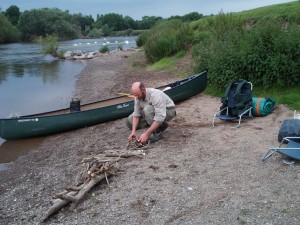


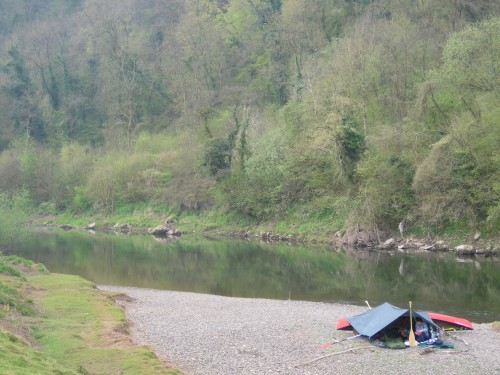
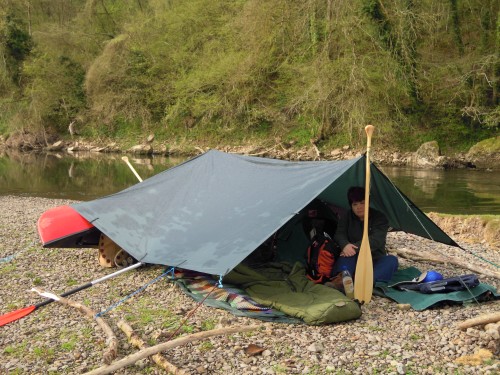
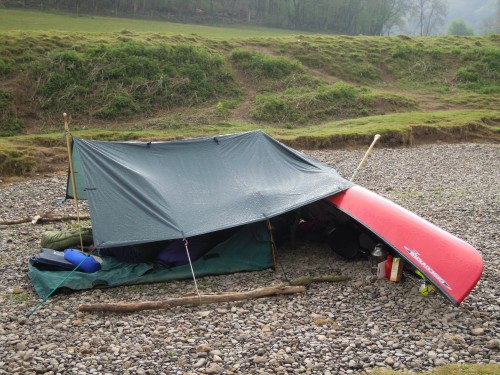
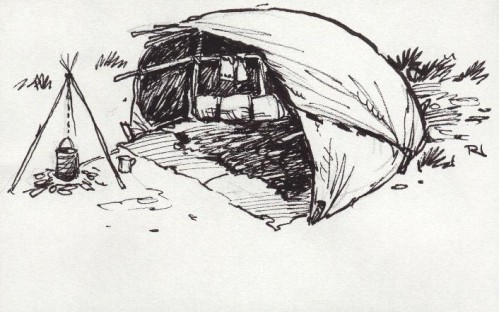
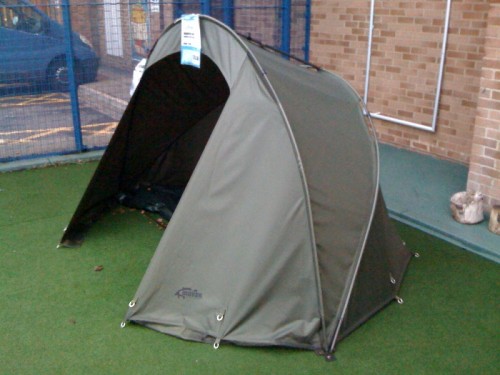

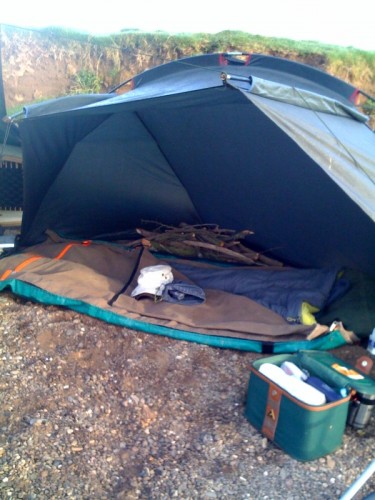
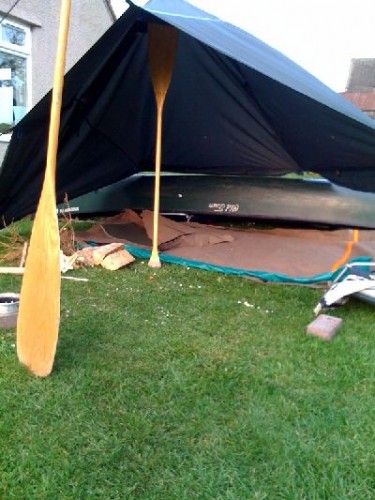
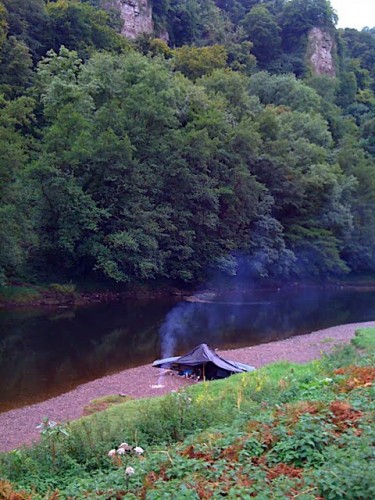
![Reblog this post [with Zemanta]](http://img.zemanta.com/reblog_e.png?x-id=e172d609-76f2-43ca-9b7d-03a337d79e4f)
![Reblog this post [with Zemanta]](http://img.zemanta.com/reblog_e.png?x-id=50d8353d-dd6e-4b4f-936f-6b5e4062b102)